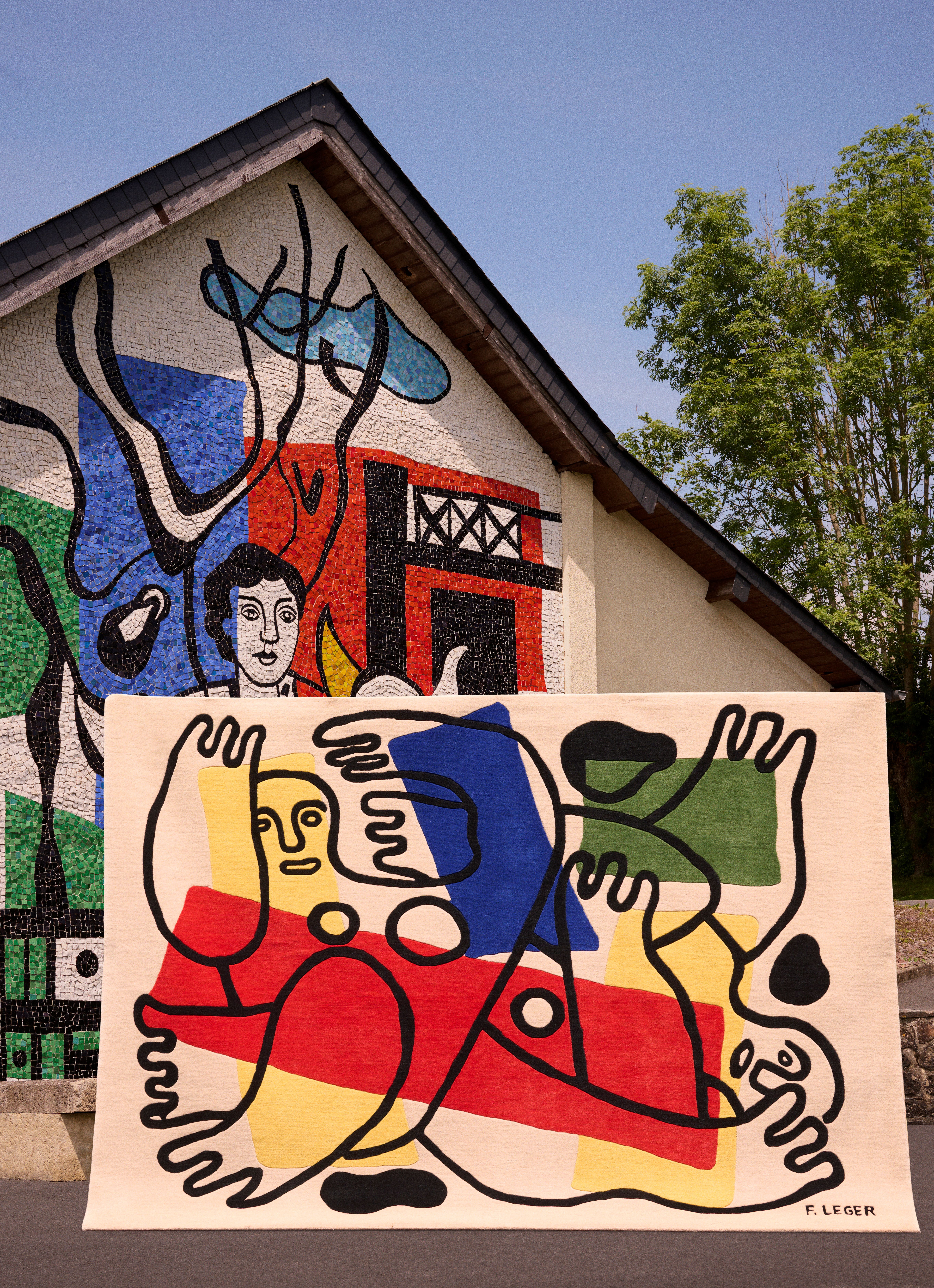Rug designer Sibylle de Tavernost’s homage to Fernand Léger
Abstract modern art, craft heritage and contemporary life fuse in Sibylle de Tavernost's new limited-edition rugs

Designer Sibylle de Tavernost pays ‘Homage to Fernand Léger’ with a new collection of limited-edition rugs. The pieces reframe the artists’ legacy through de Tavernost’s contemporary lens and expand the appreciation of Léger’s work for new generations. For the descendants of the French artist (1881-1955) who manage his estate, the collaboration was an opportunity to translate his abstract, geometric and poetic language of modernity into today’s terms, moving it beyond museums and into the daily life of eclectic living rooms.
Sibylle de Tavernost’s rugs pay ‘Homage to Fernand Léger’

Sibylle de Tavernost with her rug of Éléments sur fond bleu, 1949
After nearly a year of research into the breadth of Léger’s oeuvre – from ceramics, mosaics and stained glass at the Ferme-Musée Fernand Léger in Lisores, to uncovering delicate drawings and rare books in a private treasure trove of a Parisian apartment – de Tavernost finally settled upon four creations to translate: the intertwined figurative lines of Les plongeurs (1943), the bold embrace of Éléments sur fond bleu (1949), the dynamic scenery of the Femmes au perroquet mosaic (1951) and the génial Cheval sur fond jaune (1953) created as a tapestry.

Les plongeurs, 1943
‘Each rug reflects a different period of Léger’s work,’ she says. ‘I wanted to express his eclecticism, yet I also had to feel an instinctive emotion in front of each one.’ Empathy is essential to any good translation, and throughout the process de Tavernost drew from her own lifelong proclivity to abstraction, inspired by her grandfather, who painted every Sunday in a style that referenced Kandinsky, Léger and Miro. His paintings were the subject of her first-ever series of rugs seven years ago, in 2017.

Éléments sur fond bleu, 1949
‘At some point, I started to see life in rugs’
Sibylle de Tavernost
For the materiality of the rugs, de Tavernost imagined a ‘matte’ effect, like the texture of Legér’s thickly layered canvases, opting for wool without a silk mix at 12,000 knots per square metre. To create her pieces, which for this collection are limited to only 15 per format, she works closely with Ifrah, an entrepreneur based in northern India near the border of Nepal. Together they have established a dedicated workshop that continues the ancestral expertise of traditional hand-knotting techniques.

Les femmes au perroquet, 1951
The fusing of modernity and tradition has always been an interest for de Tavernost, perhaps thanks to her upbringing in Haussmannian apartments in Paris where grand fireplaces and high ceilings with decorative mouldings meet vibrant collages of contemporary objects. Intimately acquainted with these interior dimensions, she began to picture their floors as vessels for abstraction: ‘At some point, I started to see life in rugs – when riding my horse through the autumn leaves, or on holiday walking across the rocks by a lake in Capri.’

Cheval sur fond jaune, 1953
Like many modern artists, Léger worked across mediums, formats and surfaces, as seen at the chapel of the Ferme-Musée Fernand Léger. This collection of rugs has liberated his artwork once again, further releasing its lively energy into the world.
It's an energy that is palpable in the series of photographs de Tavernost created with photographer Alexis Armanet at the Ferme-Musée Fernand Léger in collaboration with museum director Jean du Châtenet, an expert on the artist. The images celebrate the fusion of artistic and craft heritage, the enduring visual power of Léger’s abstraction and the joy of living consciously across every canvas from architecture to interiors, en plein air and our imaginations.
Receive our daily digest of inspiration, escapism and design stories from around the world direct to your inbox.
Harriet Thorpe is a writer, journalist and editor covering architecture, design and culture, with particular interest in sustainability, 20th-century architecture and community. After studying History of Art at the School of Oriental and African Studies (SOAS) and Journalism at City University in London, she developed her interest in architecture working at Wallpaper* magazine and today contributes to Wallpaper*, The World of Interiors and Icon magazine, amongst other titles. She is author of The Sustainable City (2022, Hoxton Mini Press), a book about sustainable architecture in London, and the Modern Cambridge Map (2023, Blue Crow Media), a map of 20th-century architecture in Cambridge, the city where she grew up.
-
 Art and culture editor Hannah Silver's top ten interviews of 2025
Art and culture editor Hannah Silver's top ten interviews of 2025Glitching, coding and painting: 2025 has been a bumper year for art and culture. Here, Art and culture editor Hannah Silver selects her favourite moments
-
 In Norway, remoteness becomes the new luxury
In Norway, remoteness becomes the new luxuryAcross islands and fjords, a new wave of design-led hideaways is elevating remoteness into a refined, elemental form of luxury
-
 The rising style stars of 2026: Oscar Ouyang is taking knitwear into new realms
The rising style stars of 2026: Oscar Ouyang is taking knitwear into new realmsAs part of the January 2026 Next Generation issue of Wallpaper*, we meet fashion’s next generation. Born in Beijing, Central Saint Martins graduate Oscar Ouyang is inspired by anime, medieval folklore and his friends’ wardrobes